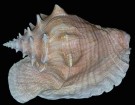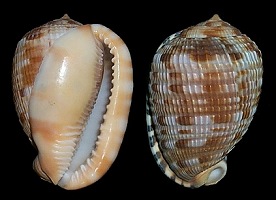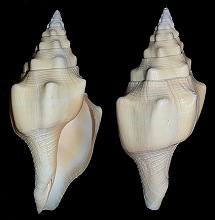|
From "Your Mantle Is Up!" To Treasures On My Mantle - An Eleuthera Shelling Adventure |
| "Your mantle is up" commented Bobbi Cordy as I hummed
and sang happily to myself while packing my shells on the last day of the May
9-14, 1999 shelling trip to Eleuthera. Bobbi continued to explain that she and
Jim, recognizing that a cowry must be happy when surrounded by its mantle, often
used that term at home to acknowledge human high spirits. And, indeed my "mantle
was up". Why? Read on. Day 1: "Yes, You Can Have Your Bananas!"
Our entry into Eleuthera, however, got off to an inauspicious start when an overly-conscientious customs official had us un-tape our ice chests with food supplies and confiscated bananas and tomatoes. I returned to him a bunch of bananas he had missed and testified to their reliable sources, and pleaded that we be able to keep them. "Yes, you can have your bananas" he finally conceded. Although we knew he was going to have those nice homegrown tomatoes for lunch. Soon we were on our way to Ethel's cottages in Tarpum Bay in the three rented cars that were waiting for us and the rest of the trip was absolute joy. Within minutes after pulling into the cottages, we had slapped our frozen foods into the refrigerators, tossed our clothes into the drawers, donned our snorkeling gear and were floating in Tarpum Bay, right across the street from the cottages. Shelling was productive: Leucozonia nassa, Prunum apicinum, Cittarium pica, Conus flavescens, Phyllonotus pomum, and Oliva fulgurator were among the finds. As we entered the schedule for the next four days, Jim suggested that Thursday, our last full day, would be best for a special excursion to a hard access spot that might harbour Conus abbotti, a shell I was especially hoping to find. Day 2: "Did I Hear, ’We're Ready’"? Restless until the group could be assembled for the next day's trip with their lunches and gear, a plaintive voice said, "Did I hear, 'We're Ready"'? Soon however, our caravan had completed a scenic ride through a garbage dump that brought us out on a rocky and sandy beach with offshore reefs and mussel beds. Soon we were facedown to business - so focused on our shelling that we barely noticed the inky black, billowy clouds that were closing in across the sky. Suddenly the placid water was blown into angry waves and the rain pelted down. Deciding it was best to just go with the flow, I just kept my face in the water, and tossing around, let the wind and wave action do my shelling for me. The turtle grass blew one way in the motion of the water and there sat a lovely lace murex, Chicoreus florifer dilectus. Then the grass waved the other way and up popped a lovely, spiny Astralium phoebium. Later I found myself in a veritable colony of carrier shells, Xenophora conchyliophora, each sporting a little green garden on its back. Wondering whether the sudden wind squall had blown them in, and collecting enough for any other sheller on the trip who might want one, I left the rest. Bountiful here were also Milk Conchs, Lobatus costatus, cockles, Laevicardium serratum, in a rainbow of colors; and other bivalves such as Codakia orbicularis and Lucina pensylvanica. A quick stop at the inland brackish lake that is the home of the famous little black murex Chicoreus dunni generously yielded for all of us not only murex, but also tiny black Fasciolaria tulipa, dark brown bubble shells and shiny fragile orange Marginella pellucida. Day 3: Long Reign The Queen The next day took us to beaches and coves out on Cape Eleuthera, at the southern part of the island. An array of beautiful coves offered a variety of habitats for all tastes. One area was rich with all three varities of helmet, Cassis flammea, Cassis madagascarensis and Cassis tuberosa. The stunning live Queen Helmet (C. madagascarensis) was an uncommon special find and there was just the one. Jim found another prize, a rare Carinate False Cerith, Fastigiella carinata. The day's take also included, shiny, fresh dark brown spotted cowries, Macrocypraea zebra, and lovely gold mouth tritons, Cymatium nicobaricum. Elsewhere in this diverse area were colorful bivalves, Asaphis deflorata in the complete yellow-red-purple color spectrum and Tellina radiata. I was thrilled with a little colony of tiny, fresh dead Sunray Tellins that I could collect by fanning the sand. Juvenile Lobatus gigas were abundant (we were literally stepping all over them). For the die-hard rock turners up came Probata barbadensis, Typhis pinnatus, Aspella paupercula, Pecten antillarum, and Pecten ornata. Another beach stop on the way home yielded a large brown and white Fenimorea fucata. Day 4: Potholes Worse Than Pittsburgh's – Shells The Best Of All Lurching over potholes more challenging than those left in roads during a typical Pennsylvania snowy winter, through cactus and thick foliage as well, our skillfully steered cars brought us to the very southernmost point of the island at the lighthouse. While shells were not prolific at this postcard-perfect beach area, we still emerged with beautiful large tellins, and a long, shiny gray Hastula cinerea. Another drive and we spilled out at Millar's Beach, which several on the trip felt offered the most outstanding shelling of all. And indeed there were more mitres than in the College of Cardinals: Atlantilux puella, Neotiara nodulosa, Pusia albocincta, the uncommon Pseudonebularia semiferruginea and Probata barbadensis; a variety of cones, such as Conus jaspideus, Conus flavescens and Conus regius, and the smaller cowries such as Naria acicularis and Luria cinerea. Other species included Cyphoma gibbosum, Fenimorea haildorema, Bailya parva, Coralliophila caribbea, Semicassis granulata granulata, Marginella guttata and another Fastigiella carinata (found by Bobbi). Day 5: Abbott-I? Thursday - our scheduled trek to "Abbott Country," finally came along. All systems seemed "go," with good weather and an offshore breeze. Jim and I trudged a long distance up a sandy beach and around a rocky spit to another beach facing the ocean and along it - until at last Jim said "We can go in here." In we plunged, heading outwards and then parallel to shore, hopefully being near the special spot where, lurking under rocks, the elusive cones might be found.
This is what happened to me. It must have been two hours and I lackadaisically turned over a small, nondescript rock I had almost passed completely by. Under it - two Conus abbotti. Staying in the same area, I found three that almost got away. I turned over a big rock and at the base were two nebulous shapes that I ignored. After I turned the rock back and was swimming off, an inner voice said: "Better take another look at that base." I returned, and the "shapes" were not only two more C. abbotti but also another I had not seen at all the first time.
Shellers at other beaches also had a successful day of finding tiny treasures in the shore drift. Particular highlights included two nice sized Gyroscala lamellosa; and a variety of limpets, including Betty Lawson's beautiful pink Fissurella fascicularis. Day 6 - After Shell Life Each night, we would all have a bit of "shell and tell," admiring and clucking over each others' finds. Dinner and games followed. Some of the men played chess, while the women settled for the word recognition game "Boggle". In our cottage, fueled by ice cream and cake, we played energetically - Bobbi's vocabulary boggles my mind! There was also a fine purchase of deep pink conch pearls transacted with island natives.
While I wouldn't presume to select a "shell of the trip" - there are so many to choose from. I can mention those finds among all shellers that to me were the most exciting: The Carinate False Ceriths, the Queen Helmet, the two wentletraps, one of the Milk Conchs with a lavender aperture and of course, the Conus abbotti. I was especially thrilled when Jim told me one of my specimens, orangey red instead of olive brown, was an unusual color. When all is summed up, we collectively found over 70 different species! During the trip, walking by a sandy plant bed directly underneath the cottage porch railing, I noticed two spines sticking up. Digging, I soon uncovered a spiny Astraea phoebia. Some unsuspecting sheller displaying the shell on the rail at an earlier time must have knocked it oft. While waiting for our plane to come, we did a last round search for land snails around the airport. You just never can tell where you're going to find something, or what you are going to find, in shell-filled Eleuthera. Go there and see for yourself! Back home, the Astraea phoebia cleaned up beautifully - it's three inches in diameter and subtle burnt gold color. And, even better, as I place up on my mantle the display boxes containing all my recently acquired treasures, I find once again, that "my mantle is up!" *Adapted from an article published in The Capsule, newsletter of the Astronaut Trail Shell Club, Volume 31, No. 6, July/August 1999. |
 The rest of our party, Betty Lawson, Carol and Art
Hough, Jan and Jack Alexander, BJ and Larry Shoupe' and Ed and Viola Phelps,
assembled at the Jet Port in Fort Lauderdale and were soon headed for Eleuthera
in two tiny twin engine planes. The first thrill of the trip was simply looking
down into the sea, gazing at the curves and gradations of color visible as the
waters go from deep to shallow, as sand flats and plateaus surface and then are
covered. I imagined an artist with a palette of cobalt blue, navy blue, tan,
yellow, mustard and light green putting dabs of paint down on a canvas and
swirling the brush through to get the unique, dynamic effect that enthralled me
until we landed at Rock Sound.
The rest of our party, Betty Lawson, Carol and Art
Hough, Jan and Jack Alexander, BJ and Larry Shoupe' and Ed and Viola Phelps,
assembled at the Jet Port in Fort Lauderdale and were soon headed for Eleuthera
in two tiny twin engine planes. The first thrill of the trip was simply looking
down into the sea, gazing at the curves and gradations of color visible as the
waters go from deep to shallow, as sand flats and plateaus surface and then are
covered. I imagined an artist with a palette of cobalt blue, navy blue, tan,
yellow, mustard and light green putting dabs of paint down on a canvas and
swirling the brush through to get the unique, dynamic effect that enthralled me
until we landed at Rock Sound. You know the feeling when you first plunge in the
water on a shelling trip and the bottom rushes into your sight of elation and
optimism when you sense that the underwater scene is the kind that might be a
good shell habitat. Even if you are not finding anything, this feeling lasts for
a while before gradually descending into despair. You have turned over and back,
rock after rock, showing Herculean strength and you didn't think you had. It
seems you have fanned enough sand to cover the earth around and swallowed most
of the water in the ocean. And still - nothing. You now worry that you are
simply retracing the same territory. You are shivering and about ready to paddle
in and sadly pack it up, when suddenly (and literally) pay dirt!
You know the feeling when you first plunge in the
water on a shelling trip and the bottom rushes into your sight of elation and
optimism when you sense that the underwater scene is the kind that might be a
good shell habitat. Even if you are not finding anything, this feeling lasts for
a while before gradually descending into despair. You have turned over and back,
rock after rock, showing Herculean strength and you didn't think you had. It
seems you have fanned enough sand to cover the earth around and swallowed most
of the water in the ocean. And still - nothing. You now worry that you are
simply retracing the same territory. You are shivering and about ready to paddle
in and sadly pack it up, when suddenly (and literally) pay dirt! With this luck and feeling a peaceful closure as if I had just entered shell
heaven, I decided to drift in. Imagine my delight again when I could tell by
telltale outlines in the sand bellow that I had hit "tellin territory." Like a
bird diving for a tidbit, each time I saw the shapes, I jackknifed with new
energy towards the bottom about 10 feet below me and ended up with about 15
beautiful fresh-dead shiny, colorful pairs. Jim similarly was successful in his
C. abbotti finds. Before we called it a day, as further dividends,
there were also an unusual Risomurex roseus, Cypraecassis testiculus,
Cymatium nicobaricum, Conus verrucosus, Leucozonia ocellata, Atlantilux puella,
and Engina turbinella.
With this luck and feeling a peaceful closure as if I had just entered shell
heaven, I decided to drift in. Imagine my delight again when I could tell by
telltale outlines in the sand bellow that I had hit "tellin territory." Like a
bird diving for a tidbit, each time I saw the shapes, I jackknifed with new
energy towards the bottom about 10 feet below me and ended up with about 15
beautiful fresh-dead shiny, colorful pairs. Jim similarly was successful in his
C. abbotti finds. Before we called it a day, as further dividends,
there were also an unusual Risomurex roseus, Cypraecassis testiculus,
Cymatium nicobaricum, Conus verrucosus, Leucozonia ocellata, Atlantilux puella,
and Engina turbinella. In shelling, it seems as if each person has different
wants and interests, and that each person actually finds what he or she is
looking for. Some wanted large shells and some wanted small. Sizes of shells
gathered by all ranged from a huge West Indian Chank, Turbinella angulata,
to an utterly miniscule Triphora nigrocincta. For non-shelling
spouses, there was excellent fishing.
In shelling, it seems as if each person has different
wants and interests, and that each person actually finds what he or she is
looking for. Some wanted large shells and some wanted small. Sizes of shells
gathered by all ranged from a huge West Indian Chank, Turbinella angulata,
to an utterly miniscule Triphora nigrocincta. For non-shelling
spouses, there was excellent fishing.